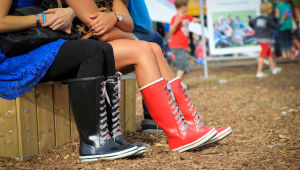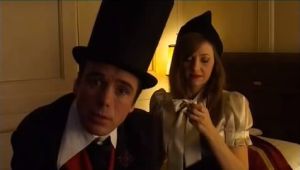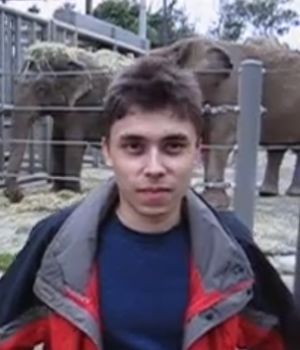Ken Kesey's Magic Bus; If only a ride on the N159 was this exciting
The Magic Bus pulls up at the Peace Monument late on Friday afternoon, bringing a blaze of colour and a blast of noise to the Brighton sea front. On the roof platform standing between the loudspeakers a new-generation Merry Prankster, swathed in dayglo rags and wearing a microphone headset, conducts the crowd gathering around the vehicle. As Bob Dylan sings "Everybody must get stoned," bubbles stream from the windows and the crowd is implored to join in. They respond, albeit a little uncertainly. "Man," says the new-generation Prankster, "you people really are all sooo beautiful."
Ken Kesey's original Magic Bus made an epoch-defining, LSD-fuelled trek across America in 1964, and was immortalised in Tom Wolfe's book Electric Kool-Aid Acid Test. For the wide-eyed kids and tie-dyed hippies, it hardly matters that the first school bus is now rusting in a swamp back on Kesey's farm in Eugene, Oregon. This one, a 1947 American International Harvester school bus, has the same purpose, freeing novelist Kesey from the isolation of writing to engage in interactive theatre with his extended family and anyone else who happens along for the ride. It seems to work too, at the very least coaxing a smile from everyone who sees it.
A functioning museum piece, an instant magnet for the curious, it is full of charm, wonder, aged Pranksters and their offspring.
Festooned with swirls of paint, murals of superheroes, characters from the Wizard of Oz and the Sistine Chapel, a leopard, various birds, fishes and psilocybin mushrooms, it glitters with fake diamonds, mirrors and psychedelic mosaics. A functioning museum piece, an instant magnet for the curious, it is full of charm, wonder, aged Pranksters and their offspring.
Up to 40 people, aged between seven and 70, are travelling on the bus and in a convoy of mini vans. They include Faye, Kesey's wife of 45 years, his 60-year-old brother Chuck, his children, grandchildren, and veterans from the 1964 trip including Mountain Girl (the mother of one of Kesey's children), Anonymous, Mal Function and several kids of friends and neighbours who have no time or inclination to get back on the bus. "We're here to have the fun our parents are too old to have," grins one of the Pranksters- in-waiting, a fresh-faced teen called Eli.
The Prankster known as Are We Really?, who files daily travel reports on their Intrepidtrips website, takes the crowd on a guided tour. He asks them to call out the letters painted on its destination board" `FURTHER'. That's right. Everytime we get on the bus that's where we go, further - further than we've ever been before," he says. He points to a painted hand with half of its third finger missing. "That's Jerry Garcia's hand. [The leading light of The Grateful Dead]. He died recently but Kesey compares him to Jesus: he says he was a prophet, a cultural warrior. We like to think that we're bringing his spirit along for the ride."
Kesey provides the focus for another throng. Holding court, he signs books, a skateboard, a disposable nappy, a P45 and anything else that comes his way. A genial white-haired man in his sixties, he still has the round-shouldered physique from his days as a college wrestling champion, but there is occasional slight hesitancy in his speech and bearing. Admittedly he's staving off the effects of long-haul flight with generous measures of gin and tonic, but the shakiness is a reminder of a mild stroke he had two years ago. In recent years, several of his Prankster associates - Garcia, a girl called Stark Naked and the man called Zonked - have all passed on. Kesey knows his Travelling Circus cannot last forever. This month-long British tour has only happened because Channel 4 has helped finance it and this may be the last chance for Kesey to recapture some of the mad, unwieldy glory of the 1964 trip.
The tour is entitled "Where's Merlin?", the avowed purpose to seek out and summon up the spirit of the Arthurian sorcerer whom, legend has it, will reappear on English soil before the end of the millennium. Of course, this being a Prankster venture, it would be wise not to take any of it, least of all The Quest For Merlin, the musical passion play they'll be performing during their trip, too seriously. "None of us can really act or even remember our lines," admits Kesey.
The real purpose of the visit is to keep alive the energetic mischief he espoused in the Sixties.
The real purpose of the visit is to keep alive the energetic mischief he espoused in the Sixties. He makes this clear during the signing session when someone hands him a book by Neal Cassady, driver on the original trip and eulogised as Dean Moriarty in Jack Kerouac's On The Road.
"What we are doing here is preserving Neal's energy. His mind worked differently to other people's minds. He was pushing all the goddamn time, he made you feel ashamed, feel that you were slacking.
"Garcia said the 60s ain't over `til the fat lady sings and that's what's happening here, the same old hippy bullshit. Love, love, love - I don't know a better way to do it."
When Kesey is finally wrested away (parting words of wisdom: "I'm not proselytising for LSD anymore. There's not enough of the good stuff to go round, for one thing"), the Prankster troupe moves to the Travel Lodge in Hickstead, an evening stopover before the visit to Stonehenge. Kesey carries on drinking and talking in the Castle Inn Pub, spending most of the evening with Arthur Pendragon, a self-proclaimed "wizened king" dressed in Druid robes.
Someone questions the wisdom of what he's embarked on with the Merlin trip - why is the acclaimed author of One Flew Over The Cuckoo's Nest and Sometimes A Great Notion, travelling around the country with "a bunch of bozos"?
Ken Kesey; A man almost as colourful as the bus itself
"There are spirits moving us around this earth and when you catch a wave you know it," says Kesey. "People talk about being addicted - that's what I'm addicted to. Sometimes if you're a writer that leads you to writing a book, sometimes it doesn't. Either way, I'm a good storyteller, that's what we do. Come into town do some magic, tell tales and move on."
Next morning, Kesey is at the front of the bus drinking a beer as we head for Stonehenge. Inside, the walls are covered with pictures of icons and heroes, and the Pranksters sprawl out on bean bags and sleeping bags. Through the internal speaker system various Pranksters imitate farmyard noises when the bus passes a field of sheep or cows. Music plays constantly. Mountain Girl reads from a book of Arthurian legend, and the Pranksters, "charmed to death" by the countryside, seem remarkably undamaged by the excesses of the past. A few joints are passed around, but these days the strongest drink on offer is Sunny Delight mixed with vodka, rather than Kool Aid laced with acid.
Chuck Kesey, on the bus for only a few days before he goes back to his dairy farm in Oregon, extols the virtue of cordyceps, which has for many Pranksters replaced LSD. "It's not hallucinogenic but it makes you feel real good. I'd advise everyone to buy stock in it," he twinkles. This mysterious product is extracted from a fungus that grows on caterpillars and is used in Chinese medicine to combat physical and mental fatigue.
In the villages we pass through, the bus's magic is working. Whatever their attitude towards drugs, counter-culture and loud Americans, people can't help looking, smiling and waving as soon as they see this apparition and its wayward cargo.
When we finally get there, the cordoned-off, English Heritage-run Stonehenge is a disappointment to Kesey. He was last here in the early Seventies with some Hell's Angels and Jerry Garcia. Back then there was, he intimates, wild and libidinous happenings among these ancient stones after night fall.
Now as he walks and talks among the milling tourists, his physique and stars and stripes apparel seem to attract curiosity just like the magic bus. As people gather around he does a simple magic trick and tells tales that are alternatively moving and far fetched, puzzling and captivating.
Earlier Chuck had told me he thought Ken was wrong when he described the bus as his best work. The Keseys were always great storytellers, but their grandfather was illiterate. Ken was the first to graduate, to prove himself as a writer and he wishes his brother would write more.
Back outside the bus, Kesey is preparing to go on the next stage of the bus ride to Cornwall for the eclipse. I ask him about the novel-writing career he has all but abandoned. He says he still writes a little every day and keeps a regular journal, but the feeling doesn't compare with what he had when he first wrote, often high on acid, back in the early Sixties. Now it just gets harder and harder to find the words and the sense of reward. "Coming here and doing this, it just feels better, there's so much stuff going with the Internet, meeting people. It's more immediate. And a lot more fun."
He smiles, pats the side of the bus like it was a trusty steed and gets back on board.



